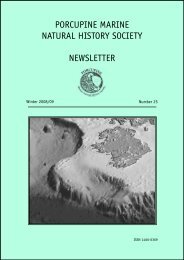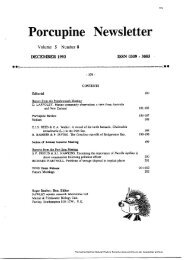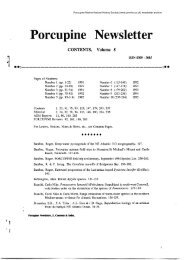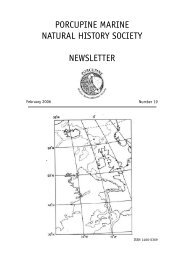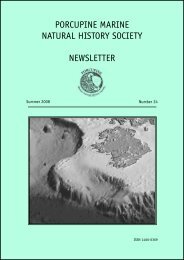Porcupine Newsletter Volume 1, Number 10, August 1980.
Porcupine Newsletter Volume 1, Number 10, August 1980.
Porcupine Newsletter Volume 1, Number 10, August 1980.
You also want an ePaper? Increase the reach of your titles
YUMPU automatically turns print PDFs into web optimized ePapers that Google loves.
PATELLA EXCLUSION EXPERIMENTS ON THE ISLE OF MAN<br />
S.J. Hawkins, Marine Biological Association Laboratory, Plymouth, Devon<br />
Previous experimental removal of Patella, and observations following large-scale kills<br />
caused by oil pollution and treatment have shown the importance of Patella in regulating<br />
algal growth on moderately-exposed and exposed rocky shores (see southward and<br />
Southward, 1978, for review). As a preliminary experiment, I removed Patella during<br />
March 1977 from a 2m strip down a Balanus covered shore in a similar manner to the<br />
classical experiments of the 1940's. Diatoms rapidly grew, followed by green algae<br />
and after 4 - 5 months by Fucus sporelings which eventually formed a thick sward<br />
down the shore. Little growth occurred in adjacent control areas.<br />
The influence of season on the sequences of algal colonization of barnacle covered<br />
exclusion areas was examined by smaller scale, more tightly controlled experiments,<br />
using 1" high wire fences fixed to the rock. The pattern of algal colonization varied<br />
markedly with the season in which the exclusion was set up. In autumn diatoms were<br />
followed directly by -- Fucus sporelings; in winter and spring diatoms were followed by<br />
green algae and afterwards by Fucus sporelings; in late summer Fucus recruited directly.<br />
Little algal growth occurred in the adjacent controls. The initial stages of<br />
algal colonization did not seem necessary for the subsequent recruitment of F'ucus<br />
sporelings.<br />
A second series of experiments, also set up at various times of the year, tested<br />
the influence of Balanus cover on algal colonization. Barnacles were scraped from<br />
half of an exclusion area, with suitable controls set up alongside each part of the<br />
exclusion. In the experiment started in October, Fucus directly colonized the<br />
barnacle covered half of the exclusion. In contrast, diatoms followed by green<br />
algae (mainly Enteromorpha intestinalis) , and eventually only a few Fucus sporelings,<br />
colonized the scraped half. In the experiments set up in February and<br />
~~ril, Ulothrix, a small green filamentous alga, immediately colonized the scraped<br />
half, ' followed by Blidingia (a larger green alga) and then Fucus. Blidingia<br />
direct .ly colonized the unscraped half followed rapidly by Fucus in both instances.<br />
There is some indication that preliminary stages are necessary before Fucus recruitment<br />
t~ bare rock can occur. However, Enteromorpha intestinal* seems a.ble<br />
to delay establishment of Fucus sporelings for some time. There was almost no<br />
algal growth in all the controls.<br />
The results have interesting implications for the concept of succession in the<br />
intertidal. In addition, barnacles seem to facilitate "escapes" of Fucus from<br />
Patella grazing which contribute to the patchiness observed on rocky shores.<br />
For more detail see:<br />
Southward, A.J. and E.C. Southward, 1978. Recolonization of rocky shores in<br />
Cornwall after use of toxic dispersants to clean up the "Torry Canyon" spill.<br />
J.Fish Res.~d.Canada 35,682-706.<br />
Hawkins, S.J., 1979. "Field studies on Manx rocky shore communities". Ph.D.<br />
Thesis, University of Liverpool.<br />
184<br />
JOINT MEETING OF THE MAIACOLOGICAL SOCIETY OF LONDON AND THE<br />
UNDERWATER ASSOCIATION HELD IN MANCHESTER ON THE 17th NOVEMBER 1979<br />
The meeting was well attended by 80 delegates from the U.K., Ireland and Norway and<br />
the papers presented were all of a very high quality. Dr Greg Brown started the<br />
morning session with an account of his six years' work on zoogeography of nudibranchs<br />
in the North Atlantic and demonstrated that morphological specialisation becomes<br />
increasingly prevalent in those species predominating in the more southerly provinces<br />
of the region. Dr Roger Hughes then followed with a report on the research project<br />
by Dr Bob Eilner on energy maximisation in the diet of shore crabs feeding on mussels.<br />
After this he voiced some interesting thoughts on the way crab predation may have<br />
<strong>Porcupine</strong> Marine Natural History Society (www.pmnhs.co.uk) newsletter archive



